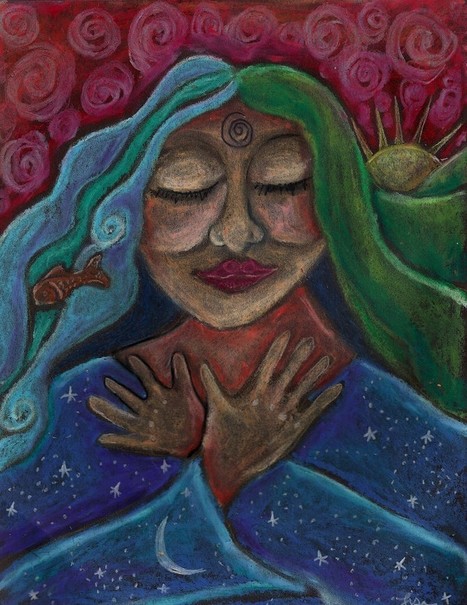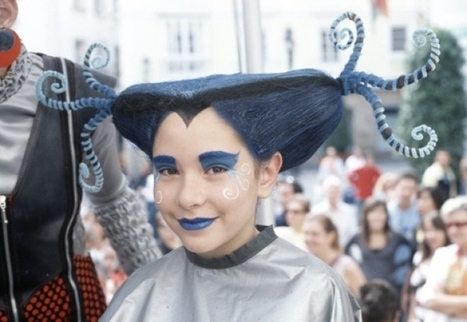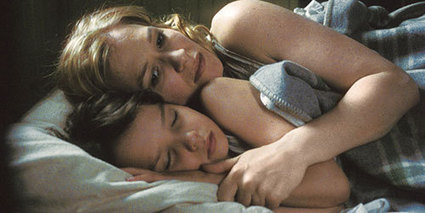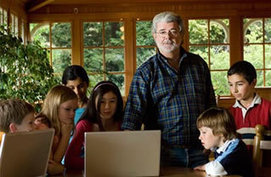 Your new post is loading...
 Your new post is loading...

|
Scooped by
Edwin Rutsch
May 30, 2014 6:03 PM
|
Produced in collaboration with visual artist and filmmaker Brent Green, Empathy School combines theater, travel, and audio in a contained space where listen

|
Rescooped by
Edwin Rutsch
from Empathy Movement Magazine
May 15, 2014 3:45 PM
|
The Empathy Circuit | The Artform of Outrospection
Empathy is a “feeling into” that evokes simultaneous knowledge of theselfand theother. Indeed, empathy has the capacity for a revolutionary epistemology, even a counter-ontology; the capacity to counter the polarisation and signifying isolation through Hegelian dialectics of these two terms; instead, we have an emotional equivalent to Humpty Dumpty’s “slithe”, a psychological portmanteau!..
A long-term and rolling project, The Brentwood Road Gallery are looking for artists, writers, psychologists, neuroscientists, educators, community activists, art therapists and anybody whose practice and research looks at the understanding and development of empathy within both the contemplative and scientific perspectives.
image: http://en.wikipedia.org/wiki/File:The_Gallery_of_Cornelis_van_der_Geest.JPG

|
Rescooped by
Edwin Rutsch
from Empathy Movement Magazine
April 15, 2014 11:38 AM
|
By Ted Fickes You need not have watched the first U.S. presidential debate on October 3rd to know what happened. Mitt Romney won the debate in the eyes of most that watched. He succeeded, in part, by creating a narrative, telling stories, and using a strong sense of empathy to connect with citizens.
The power of empathy in Governor Romney’s debate performance (and the lack of it displayed by President Obama) has been declared significant enough to perhaps turn Romney’s campaign from a languishing also-ran to a possible winner.
But it is empathy that gives stories
their power in advocacy and
campaign communications.

|
Scooped by
Edwin Rutsch
March 24, 2014 2:08 PM
|
Beautiful, inspiring & mind-blowing images on HighExistence

|
Rescooped by
Edwin Rutsch
from Empathy Movement Magazine
March 16, 2014 7:37 PM
|
The Deseret News assembled a panel to review the many benefits of theater for young audiences in recognition of the World Day of Theatre for Children and Young People.
Children learn social skills through theater, and the experience gleaned through both performing and attending theater has been likened to a gym for empathy, because it’s a place where muscles of compassion can be strengthened.
======================= Children learn to understand and engage with people who are different from them. =============

|
Rescooped by
Edwin Rutsch
from Empathy Movement Magazine
March 1, 2014 1:36 PM
|
“Healing the self means committing ourselves
to a wholehearted willingness to be what
and how we are–
beings frail and fragile,
strong and passionate,
neurotic and balanced,
diseased and whole, ...
by Lisa

|
Rescooped by
Edwin Rutsch
from Empathy Movement Magazine
February 13, 2014 3:53 PM
|
Childhood is so special because children have a natural tendency to be creative - every child is an artist in that way,” continues FitzGibbon.
“All that encourages creativity and imagination is linked to empathy and empathy is all about becoming a good, feeling and right-thinking adult. All the studies show that children who are read to when they are young and who are helped to draw and engage with art develop into more empathetic and well-rounded adults.
==================== All that encourages creativity and imagination is linked to empathy ============== “A lot of work has been done to show that children who are encouraged to imagine and dream become better at recognising and understanding emotion in later life, better at empathising, better at problem solving.

|
Rescooped by
Edwin Rutsch
from Empathy Movement Magazine
February 10, 2014 1:50 AM
|
This interdisciplinary symposium invites scholars, filmmakers, mental health practitioners and consumers to explore questions about representations of mental illness in film and television across two days of papers, screenings and workshops. The symposium has a particular focus on women’s mental health and the portrayal of mental illness in Australian films.
============================== KEYNOTE LECTURE Professor Raymond Gaita The University of Melbourne The Limits of Empathy ==============
A key theme of the symposium is the emotion of empathy. If sympathy suggests feeling for someone (that is, feeling sorry for them), empathy is distinguished by feeling with them.
This sharing of emotion gives us valuable insight into how things are with another person. This insight can lead to a greater understanding that reduces stigma and discrimination, and helps us to see ‘the other’ as an equal human being.
That is why empathy is such an important concept in philosophy, politics, psychology and human rights education.

|
Rescooped by
Edwin Rutsch
from Empathy Movement Magazine
February 10, 2014 1:50 AM
|
With the recent success of films such as Silver Linings Playbook and TV shows like Homeland and United States of Tara, there has been a marked shift in how mentally ill characters are portrayed on screen.
Dr Hopgood points to these guidelines as evidence of the shift towards empathy. “By moving away from stereotypes and stigmatising representations towards more accurate and sensitive portrayals, filmmakers and TV producers can develop a stronger emotional connection between a character who is mentally unwell, and the viewer,” she says. “The storytelling becomes richer, more creative, and ultimately more satisfying.”
This shift towards empathy is the focus of an upcoming two-day event to be held at The Dax Centre
This shift towards empathy is the focus of an upcoming two-day event to be held at The Dax Centre on 13 and 14 February. The interdisciplinary symposium, Try Walking in My Shoes: Empathy and Portrayals of Mental Illness on Screen, will bring together filmmakers, academics, mental health professionals and the public to explore questions such as: How is mental illness represented in film and television? What emotions are elicited from the viewer? by Ryan Sheales

|
Rescooped by
Edwin Rutsch
from Empathy Movement Magazine
February 5, 2014 1:19 PM
|
At the Writing for the Soul conference, one of my six fiction classes will focus on creating immediate character empathy — in your novel’s first chapter.'
Why create empathy? Because even in a plot-driven story, characters areeverything. The most intriguing plot will fail if a reader doesn’t care about your characters. Most of these methods work best when combined with at least one other. (In the Writing for the Soul class, I’ll go into more detail about each.) Readers will empathize if the character is:
1. Clearly displaying a valued trait ...
By Brandilyn Collins

|
Rescooped by
Edwin Rutsch
from Empathy Movement Magazine
January 23, 2014 1:43 PM
|
More than individuals, we are part of a social collective called humanity. As members of this collective, the perception of our own identity is based on our relation with other people and our social environment: how people see us, how we do act and interact with them, and what self image we project to this society and to ourselves. As part of this collective society, it is clear the importance of understanding the ‘Other’ and ‘Each Other’ to better understand ourselves. This artistic investigation plans to use the recent neuroscience approach of ‘embodiment’ and apply it to investigate the perception and comprehension about the Self based on the comprehension of the “Other”.

|
Scooped by
Edwin Rutsch
January 13, 2014 3:48 PM
|
Empathy
A Poem by Arrinae'
This swirling storm around me,
It numbs my heart.
Slowly, but surely,
Its tearing my apart. I can't stop it, no, Though it overwhelms me so easily.The pain and turmoil I feel, From taking their pain and misery.

|
Rescooped by
Edwin Rutsch
from Empathy Movement Magazine
December 10, 2013 1:13 PM
|
We have a sense of empathy with works of art. If we see gestures in a portrait, we actually almost simulate those gestures in our mind. We often implicitly act as if we are moving our arms in response empathically to what we see in the painting. We also respond empathically to what we think the sitter is experiencing in their head. So we have what is called “a theory of mind” in which when I look at you, I have a sense of where you’re going and you have a sense of where I’m going. We have an enormous capability by just looking at the person we are interacting with, and particularly if we’re having a conversation, to predict certain aspects of future events simply by looking at them. This is an extraordinary capability that human beings have. by ERIC KANDEL
|

|
Scooped by
Edwin Rutsch
May 22, 2014 2:21 PM
|
Empathy (affective sensitivity) was hypothesized to be positively related to creativity and expressiveness and inversely related to dogmatism, when gender and age were controlled.
Participants were 56 graduate students enrolled in counseling and educational psychology courses at a large southwestern (U.S.) university. Participants were administered the Affective Sensitivity Scale (Kagan & Schneider, 1977) to measure empathy, the Statement of Past Creative Activities (Bull & Davis, 1980) to measure creativity, the Opinion Scale (Kleiber, Veldman, & Menaker, 1973) to measure dogmatism, and the Extended Personal Attributes Questionnaire (Spence, Helmreich, & Holahan, 1979) to measure expressiveness.
The results of multiple regressions provide support for the hypotheses that empathy is positively related to creativity and inversely related to dogmatism,
but the results do not support the hypothesized positive relationship between empathy and expressiveness. Implications of these findings for persons serving as counselors and counselor educators are discussed.

|
Rescooped by
Edwin Rutsch
from Empathy Movement Magazine
May 4, 2014 2:38 PM
|
by Suzanne M. Peloquin Empathy is central to the interactions of occupational therapists who value personal dignity. Persons from various sectors of the behavioral sciences and the medical humanities have proposed that engagement with the arts can develop empathy, an assumption that prompted this inquiry.
The observations of artists and art philosophers suggest that the assumption that art may develop empathy is grounded in the kindred natures of the two practices and in the actions that occur when a person engages with a work of art.
The assumption that art may develop empathy is grounded in the kinship of the actions common to both practices: response, emotion, and connection. Artists and art philosophers’ observations of human practices have uncovered three rules of art that may dispose one toward empathy: reliance on bodily senses, use of metaphor, and occupation by virtual worlds.
Analysis of art’s potential suggests that a person who would derive empathy from art must (a) use the senses to grasp feeling, (b) stretch the imagination to see a new perspective, and (c) invite an occupation that enhances understanding.
Persons who hope to develop empathy must pursue an experience that evokes the fellow feeling that inspires it. Art can offer this experience.

|
Rescooped by
Edwin Rutsch
from Empathy Movement Magazine
April 7, 2014 2:56 PM
|
Artworks created from a collaboration between Australian Red Cross, GPY&R Sydney and 12 of Australia's leading and emerging artists to raise awareness about the impact of bushfires on the nation will be unveiled this week.
The campaign, 'Embers of Empathy', utilises charcoal from the 2013 bushfires in the Blue Mountains to create unique artworks that convey an emotive bushfire story, inspiring lessons for the future.

|
Rescooped by
Edwin Rutsch
from Empathy Movement Magazine
March 20, 2014 4:35 PM
|
Gluing readers to the page. This is a writer’s goal each step of the way, from gaining the attention of an agent, to compelling an editor to make an offer, and finally, to enthralling an audience.
We strive to make people experience something powerful when they read our words. To genuinely FEEL. To care. Sounds...um, not easy? I know! Building empathy requires skill, knowledge and practice. Writers must become deeply in tune with a reader’s emotions and learn how to use these feelings to bind them to the story...
5 Ways To Encourage Reader Empathy
- Humanize your character....
- Get inside their bones. ...
- Clearly define the needs, goals, and stakes....
- Hobble characters through challenges that readers sympathize with....
- ....

|
Rescooped by
Edwin Rutsch
from Empathy in the Workplace
March 11, 2014 11:34 AM
|
This week, I’m headed to the Future of Storytelling summit, an unusual cross-disciplinary unconference exploring exactly what it says on the tin. Among the presenters is neuroeconomics pioneer Paul Zak, director of the Center for Neuroeconomic Studies and author of The Moral Molecule: The Source of Love and Prosperity.
====================== this short film on empathy, neurochemistry, and the dramatic arc =============
In this short film on empathy, neurochemistry, and the dramatic arc, directed and edited by my friend Kirby Ferguson and animated by Henrique Barone, Zak takes us inside his lab, where he studies how people respond to stories.
by Maria Popova

|
Rescooped by
Edwin Rutsch
from Empathy Movement Magazine
February 16, 2014 6:46 PM
|
So much of toxicity in this world comes from a collective draining of empathy. We don't understand each other, and we don't want to. But theater forces us to empathize.
As my friend Bill English of San Francisco's SF Playhouse says, theater is like a gym for empathy. It's where we can go to build up the muscles of compassion, to practice listening and understanding and engaging with people that are not just like ourselves.
=========================== theater is like a gym for empathy. It's where we can go to build up the
muscles of compassion,
to practice listening and understanding ========
Kids need this kind of practice even more than adults do. by Lauren Gunderson Dramatist and theater essayist

|
Scooped by
Edwin Rutsch
February 10, 2014 11:39 AM
|
Modern and historical scholarship on empathy has consistently demonstrated that people are more likely to empathize with those who are similar to themselves. This empathic bias for similarity means that the affective bonds and ethical motivations that accompany empathy are significantly diminished in relationships with outgroups, as defined by sociological difference.
==========================
Modern & historical scholarship on empathy has consistently demonstrated that people are more likely to empathize with those who are similar to themselves. =============
I argue that narrative empathy is uniquely capable of circumventing the similarity bias through compositional strategies related to foregrounding and perspective. Turning to modern research on reading as well as to accounts of reading in the nineteenth century, I propose a two-part argument: first, that the act of reading can overcome the bias that scholars have observed in relationships between people and, second, that narrative empathy has the potential to prevent future cases of bias by reconfiguring readers' criteria for similarity.
In an extended case study of Elizabeth Gaskell's novel Mary Barton: A Tale of Manchester Life (1848), I argue that Victorian social-problem literature thematizes empathy across difference and that the self-conscious treatment of cultural difference is particularly helpful for overcoming similarity bias.
by Mary-Catherine Harrison
Assistant Professor, English

|
Rescooped by
Edwin Rutsch
from Empathy Movement Magazine
February 10, 2014 1:50 AM
|
A key theme of the symposium is the emotion of empathy. Speakers are invited to examine the ways in which the viewer’s empathy is elicited (or not) by the portrayals of mental illness on screen. In addressing this theme, paper/workshop topics may include, but are not limited to:
A key theme of the symposium is the emotion of empathy. Speakers are invited to examine the ways in which the viewer’s empathy is elicited
• The role of acting and performance in the portrayal of mental illness on screen
• Conventions of genre and/or commercial considerations
• Narrative and stylistic techniques eg. sound, music, mis-en-scene
• The socio-historical context in which these portrayals are produced
• Issues of stigma and stereotypes that are perpetuated and/or challenged by screen portrayals of mental illness
• The relation between screen portrayals of mental illness and other forms of visual culture
• The ways in which gender, sexuality, class or race impact upon the representation and/or interpretation of mental illness
• The portrayal of psychiatry/psychology on screen
• The impact of screen portrayals on the lived experience of mental illness

|
Scooped by
Edwin Rutsch
February 5, 2014 1:21 PM
|
My job title is Medical Actor, which means I play sick. I get paid by the hour. Medical students guess my maladies. I’m called a Standardized Patient, which means I act toward the norms of my disorders. I’m standardized-lingo SP for short. I’m fluent in the symptoms of preeclampsia and asthma and appendicitis. I play a mom whose baby has blue lips. Medical acting works like this: you get a script and a paper gown. You get $13.50 an hour. Our scripts are ten to twelve pages long. They outline what’s wrong with us—not just what hurts but how to express it. They tell us how much to give away, and when. We are supposed to unfurl the answers according to specific protocols. The scripts dig deep into our fictive lives: the ages of our children and the diseases of our parents, the names of our husbands’ real-estate and graphic-design firms, the amount of weight we’ve lost in the past year, the amount of alcohol we drink each week.
by Leslie Jamison

|
Rescooped by
Edwin Rutsch
from Empathy Movement Magazine
January 23, 2014 1:44 PM
|
We’ve seen people use the Oculus Rift tosimulate beheadings. BeAnotherLab used the virtual reality headset for something less morbid but no less interesting. The organization’s The Machine to be Anotherwas an “artistic investigation” in which the Rift was used to give participants first person views from actual people.

|
Scooped by
Edwin Rutsch
January 21, 2014 6:06 PM
|
There are very few “provable” things in arts education, but one thing that has been “proven” over the years in educational research is that theatre education increases empathy in students. Empathy, or the ability to understand another person’s feelings or circumstances, is a critical skill for an actor. It is how we are able to portray people who are very different from ourselves. We must imagine what it would be like to undergo the circumstances of the play in order to honesty represent those emotions and conditions on stage in a believable way.
Empathy in the classroom does not need to rise to the level of believable impersonation, but increased empathy is very helpful to students as they relate to each other and to their worlds. By integrating drama into the classroom, teachers can help students increase their empathy and meet non-arts curricular goals as well. Joan Weber Director, Education Division, Creativity & Associates

|
Rescooped by
Edwin Rutsch
from Empathy Movement Magazine
December 19, 2013 5:07 PM
|
If a writer feels nothing for her characters, how can we expect the reader to feel something? Our lack of emotional investment will show on the page. Our characters will feel wooden, stereotypical, and lacking in life. Here are some ideas for developing empathy with your characters. 1. Know your characterTo feel empathy for our characters, we need to know them like we know our best friends in real life. We need to know their strengths, flaws, quirks, fears, insecurities, and what makes them laugh Karen Schravemade
|
 Your new post is loading...
Your new post is loading...
 Your new post is loading...
Your new post is loading...



































